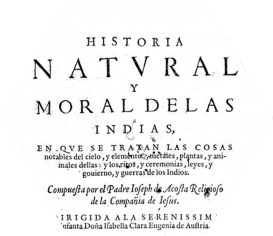Historia natural y moral de las Indias, by José de Acosta S. J. (1540–1600), was first published in 1590 in Seville, Spain. For more than fifteen years, Acosta had been a missionary and professor of theology in Spanish viceroyalties on the American continent, mostly in Peru. His Historia is a comprehensive exposition of the natural facts and peoples of the New World “discovered” by Europeans just a few decades earlier, and much of what Acosta reports is perceived by him—and received by his readers—as something new. Describing unfamiliar facts of nature (historia naturalis) and the deeds of unknown people (historia moralis) meant representing a world of unprecedented experiences, though Acosta ultimately integrates everything new into a unifying historical perspective (historia divina). Acosta did not invent the literary genre of the “natural and moral history”—he had both classical and sixteenth-century predecessors. Some important questions can be posed of all such authors. How is a discovery about facts of nature or humanity experienced? How can it be reported? And how does the direct, sensory experience of new aspects of nature relate to the endeavor of explanation?

